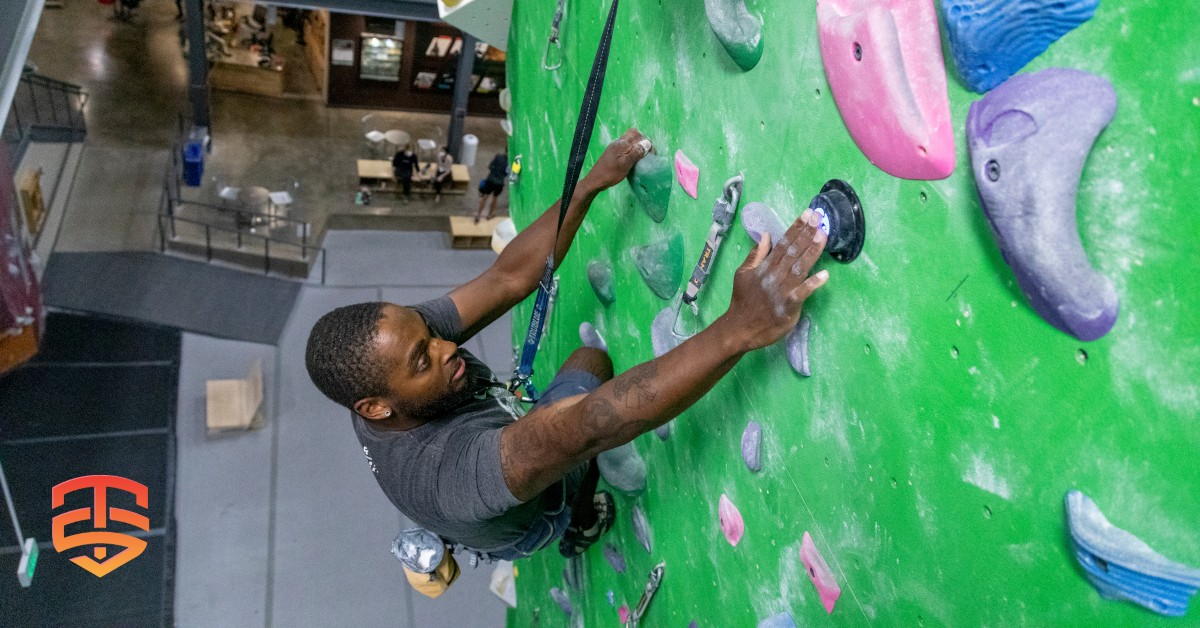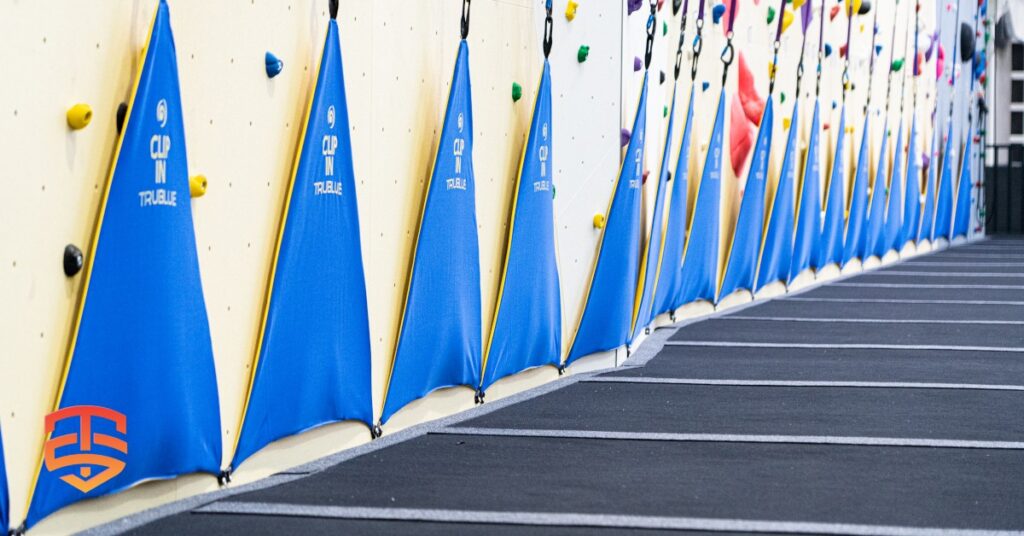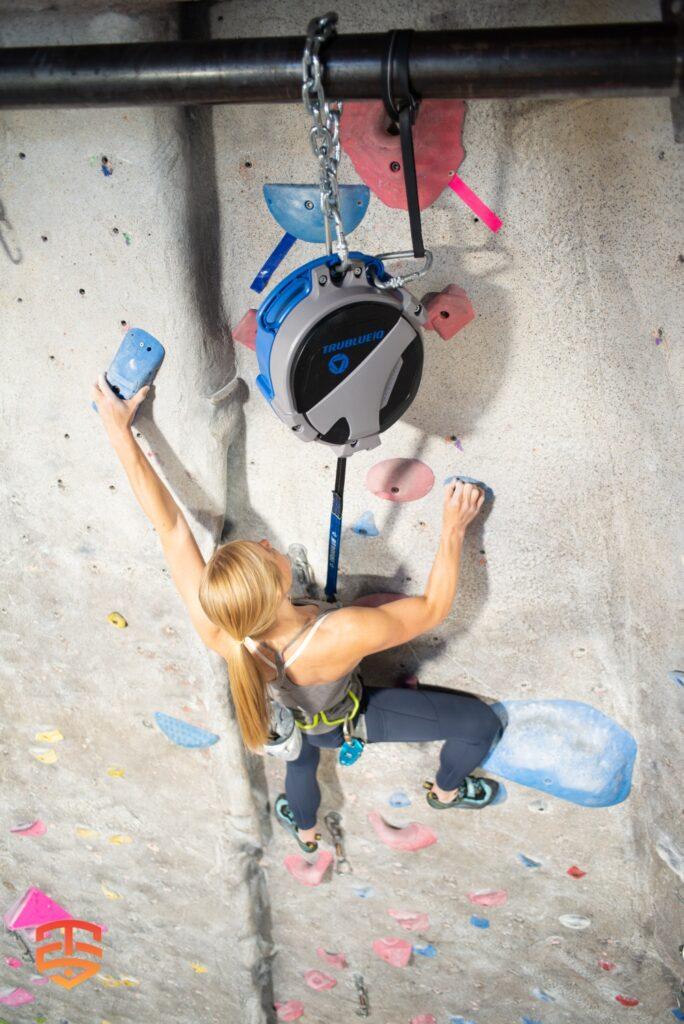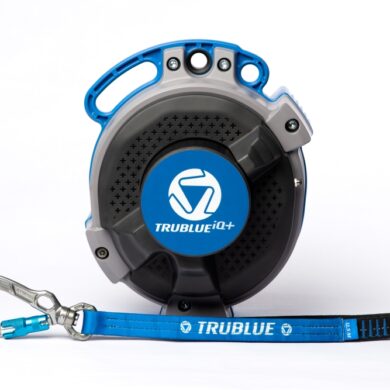
Webbing retraction is a fundamental function of all TRUBLUE devices. The retraction spring is responsible for webbing retraction and is an extremely reliable component. There are multiple factors to consider if a device is having retraction issues, and the above referenced actions should be taken to identify and potentially resolve some of the underlying causes.
Introduction to TRUBLUE retraction systems
The design of the TRUBLUE Auto Belay incorporates two independent functions: an advanced self-regulating brake system along with an automatic webbing line retraction system. The patented braking mechanism offers users a smooth descent with a minimal variation in descent rate for both children and adults, while the retraction system is intended to remove slack from the webbing as a climber ascends a route.
TRUBLUE uses a power spring, aptly named a retraction spring, to retract the webbing into our devices. As a climber progresses up the wall, the retraction spring constantly adjusts in accordance with their movements, giving the smoothest, most attentive belay experience possible.
Identifying risks and impediments to retraction
A common concern with auto belay usage is the potential to build slack in the webbing line. Excess slack can develop due primarily to external factors; however, damaged internal components may also result in a jammed or otherwise obstructed retraction system. Although retraction and braking operate independently from one another in a TRUBLUE device, when a climber falls on webbing that has accumulated slack, the braking system cannot activate until that slack has been removed from the system.
With over 40,000 TRUBLUE Auto Belays built and millions of descents performed daily, the only known slack-related injuries have been caused by external factors. We are currently unaware of any injuries related to damaged internal components, such as a retraction spring. Therefore, it is extremely important to further understand how external factors, in addition to internal factors, can impact the retraction system in order to best prevent each from posing a risk to users.
External factors which may prevent or hinder retraction
There are multiple external factors which can be responsible for introducing slack into the webbing line of an auto belay during use. Some of these factors are the result of user error, while others can be mitigated by following the recommended Inspection & Maintenance schedule located in the TRUBLUE Operator Manual.
During normal climbing, slack can be introduced if the webbing line becomes stuck around protruding handholds, climbing wall features, or climbing equipment. If the user continues to climb above this constriction point, additional slack can develop, creating dangerous fall potential.
In the case of outdoor climbing configurations, accumulated debris or foreign objects can pose a hindrance to retraction by becoming lodged in the nozzle of the auto belay. Even indoors, sufficient hair, debris, or overly frayed webbing can also jam the nozzle, either affecting retraction or preventing it entirely.
What to do if slack is introduced into the webbing line
The best strategy for mitigating slack risk caused by external factors is taking preventative actions. These actions include educating users how to test the retraction system before climbing, as well as performing recommended scheduled maintenance, device and webbing inspections, as well as annual recertification.
If slack does develop in the webbing line for reasons mentioned above, climbers should do their best to downclimb as much as possible before letting go of the wall. Once the slack has been removed, it is then safe to allow the braking system to lower the climber the remaining distance to the ground.
In the case that the webbing line is stuck around a hold or other climbing equipment, the climber should stop ascending immediately and either dislodge the webbing line by applying a flicking motion (similar to the movement routinely used to adjust the rope when top rope or lead climbing) or retreat to the ground by either downclimbing or allowing the braking system to activate.
As stated in the TRUBLUE Operator Manual, all owners and operators should devise an emergency rescue plan for any climber in distress and communicate that plan to climbers during safety orientation.
Recommendations for preventing external issues
To better identify and react to external risks, we strongly recommend that facilities require all auto belay users to complete a mandatory orientation on the safe use of the Auto Belay. In the CWA Auto Belay Position Paper, the Climbing Wall Association has provided guidelines on what to include in a standard auto belay orientation, including the identification of inherent risks. These guidelines can be found here: CWA Auto Belay Position.
Wherever possible, we also recommend that route setters avoid mounting unnecessary equipment in the path of an auto belay, thereby reducing the number of obstacles that can prevent optimal retraction.
Conducting regular inspections, as well as adhering to scheduled maintenance requirements, will minimize the risk of external items preventing retraction. Detailed accounts of how to properly conduct each type of inspection, including inspecting and evaluating webbing wear, can be found in the TRUBLUE Operator Manual located on our website: Product Manuals
Climbers and operators should both be trained and aware of the potential risks involved with accumulating slack and should test each device before use to ensure that the device is functioning properly before the climber leaves the ground. Under no circumstances should anyone climb on a device that is not properly retracting.

Issues relating to internal retraction components
Of the 40,000+ devices and millions of daily descents, we are not aware of any reported injuries resulting from a damaged retraction spring.
Given the high cyclic use an auto belay experiences, even the best-designed retraction springs may have a limited lifespan. Keeping the retraction and braking systems independent from one another provides added security to TRUBLUE Auto Belay users. In the unusual circumstance that a retraction spring becomes damaged between annual service appointments, stop use immediately.
The most obvious indication of a damaged retraction spring is that the auto belay will no longer remove slack from the webbing. In first generation TRUBLUEs, when a retraction spring is damaged, the webbing may come unspooled if sufficient downward force is applied. Since this downward force is required, unspooling should not occur while a climber is ascending. Furthermore, despite the lack of retraction, the independent braking system will continue to function, providing a safe and controlled rate of descent once the device has been weighted.
What to expect if a retraction spring breaks while in use
In the rare circumstance that the retraction spring breaks while in use, a climber may hear a popping noise and will notice that the device is no longer removing slack from the webbing line. Rather than investigating this issue from an elevated position, the climber should stop climbing immediately and either downclimb or let go of the wall, allowing the braking system to lower them back to the ground. Given the pressure placed on the device during descent and the absence of pressure during ascent, a retraction spring is more likely to break while the climber is lowering than ascending. In either case, since the braking system works independently of the retraction spring, it is still safe for the climber to descend.
If a climber experiences a retraction issue mid-climb, operators should instruct the climber to descend immediately, without pulling on the webbing.
While a retraction spring-related injury has never been reported, continuing to climb on an auto belay with a damaged retraction spring is strictly prohibited.
Preventative action against internal damage
Contributing factors of premature damage to the retraction system include unusually high cycle counts, extreme environmental conditions, regularly operating devices above max mounting height or otherwise stretching the webbing line beyond max capacity, and subjecting devices to substantial drops or impacts. Furthermore, due to the heightened tension requirements for speed climbing, uncontrolled webbing retraction can cause serious damage to the interior components of the TRUBLUE Speed.
The best way to prevent the internal retraction system from becoming damaged is to perform scheduled maintenance, including regular inspections, as detailed in the TRUBLUE Operator Manual, and to ensure that every auto belay receives routine annual recertification. In the unlikely event that a retraction spring does become damaged between annual service appointments, the auto belay in question should immediately be removed from rotation and sent for maintenance.
Conclusion
Webbing retraction is a fundamental function of all TRUBLUE devices. The retraction spring is responsible for webbing retraction and is an extremely reliable component. There are multiple factors to consider if a device is having retraction issues, and the above referenced actions should be taken to identify and potentially resolve some of the underlying causes.
Excess slack in the webbing line is always a safety concern and auto belay users should be made aware of the factors that can cause slack to develop, as well as the steps to avoid or, if necessary, react to it.
Furthermore, we recommend that all facilities review the CWA Auto Belay Position Paper and follow Inspection & Maintenance requirements detailed in the TRUBLUE Operator Manual.
Summary of Operator Tasks and Responsibilities
- All users should complete a mandatory auto belay orientation. Guidelines for conducting an auto belay orientation can be found in the CWA Auto Belay Position Paper.
- Operators must devise an emergency rescue plan for any climber in distress.
- Operators are responsible for conducting regular device inspections and adhering to the scheduled maintenance requirements, as detailed in the TRUBLUE Operator Manual.
- In the unlikely event that a retraction issue should arise while the device is in use, operators should instruct the climber to descend immediately, without pulling or otherwise adding slack to the webbing line.
- Do not climb on any device that is not demonstrating proper retracting. If proper retraction is not occurring, immediately remove the device from rotation and send it in for service.

Vertical Auto Belay systems
Grow your climbing community by providing more access to more routes for more climbers.
Auto Belay makes climbing simple and approachable, turning first-time users into return customers. TRUBLUE Auto Belays are engineered to minimize maintenance and are built to last. Our patented magnetic braking system, delivers the smoothest user experience, the highest level of reliability, and dramatically reduces device downtime.
Dive Deeper: Exploring Auto Belay Technology with Expert Insights
Auto belays are transforming the world of indoor climbing, offering convenience and safety for climbers of all levels. But how exactly do they work, and what are the key considerations for using them? To learn more about the intricacies of auto belay technology and gain valuable insights from experts in the field, check out our additional resources below…
- Comparison of Auto Belay’s: what’s new in the TRUBLUE iQ series
- Using Technology to Make Your Climbing Gym Accessible and Inclusive
- A Closer Look at the Auto Belay System
- Next Generation Auto Belay – TRUBLUE iQ
- Every modern climbing gym should have these 5 features
- Everything You Need to Know about Buying Auto Belays
- Increase Revenue and Customer Satisfaction at Family Entertainment Centers
- Catch-and-Hold: What is it and how does it work?
- Leading the Way in profitable and safe climbing
- Why Family Entertainment Centers Trust TRUBLUE Auto Belays
- Creating Value for Customers by Using an Auto Belay
- TRUBLUE iQ+ World’s first catch-and-hold auto belay
- Drive Revenue and Customer Satisfaction with Auto Belays
- 7 Ways Magnetic Braking Is Better Than Friction
- No Belayer Necessary: Understanding Auto belays
- Competitive Advantage of an Auto Belay
- ROI at Climbing Walls and Family Entertainment Centers
- Auto-Belay and hands-free climbing challenges
- Why using Auto Belays Boosts your Business
- The Science of Eddy Current Magnetic Braking
-
 TRUBLUE iQ+ | Catch & Hold Auto Belay€ 4.399,00 – € 4.759,00 Ex VAT
TRUBLUE iQ+ | Catch & Hold Auto Belay€ 4.399,00 – € 4.759,00 Ex VAT -
 TRUBLUE SPEED Auto Belay | 7,5 – 16 meter€ 2.799,00 – € 3.059,00 Ex VAT
TRUBLUE SPEED Auto Belay | 7,5 – 16 meter€ 2.799,00 – € 3.059,00 Ex VAT -
 TRUBLUE iQ Auto Belay | 4,5 – 20 meter€ 2.799,00 – € 3.159,00 Ex VAT
TRUBLUE iQ Auto Belay | 4,5 – 20 meter€ 2.799,00 – € 3.159,00 Ex VAT







